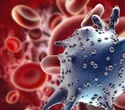Muscle wasting in cancer tied to blood vessel dysfunction
The discovery may help cancer survivors regain their muscle strength, which could contribute to better outcomes for these patients, said Dr. Jalees Rehman, senior author of the new paper and the Benjamin J. Goldberg Professor and head of the department of biochemistry and molecular genetics at the College of Medicine.
Up to 80% of patients with cancer experience muscle wasting, known as cachexia, a debilitating complication marked by extreme fatigue, weight loss and lack of appetite.
"It is one of the major determinants of poor outcomes in cancer survivors, if they're unable to engage in their activities of daily living because they've lost a lot of their muscle strength," said Rehman, who is also co-leader of the Translational Oncology Research Program at the University of Illinois Cancer Center.
As cancer progresses, a tumor molecule circulating in the bloodstream can flip a "molecular switch" in muscle blood vessel cells and cause them to malfunction, according to the study published in Nature Cancer. However, blood vessel health can be restored by turning "on" this molecular switch, thereby reversing the muscle wasting.
There's no FDA-approved treatment for cachexia, and common treatment plans focusing on nutrition and exercise don't seem to suffice, Rehman said. Past studies of cachexia focused on how an immune response leading to inflammation in the muscle might cause the condition.
Blood vessels are the highways in the body, bringing nutrients and oxygen to organs, including the muscles. But they also contribute to essential organ function and health. "They are more than just passive conduits; they help instruct our organs and tissues," Rehman said.
The researchers used an animal model of pancreatic cancer to compare the blood vessels in sick, cachexic muscles and healthy muscles. With high-resolution 3D microscopy, they showed that cachexic muscles have fewer blood vessels than healthy muscles.
They also found that these muscles had less mass and thinner fibers and couldn't perform as well on tests of strength. The same was true when they looked at models of other cancers, including colon cancer, lung cancer and skin melanoma, and when they tested muscle samples from cancer patients.
Next, the researchers analyzed the genes in cells lining the muscles' blood vessels, known as endothelial cells. The endothelial cells of cachexic muscles were more aged, leaky and prone to dying than those in healthy muscles, said Kim.
"The more vascular dysfunction there is, the more the muscle seems to suffer," Rehman said.
They found that a molecule called activin A was more prevalent in the endothelial cells with cancer cachexia than in healthy ones. This increased activin A suppressed the expression of an important protein called PGC1α," Rehman said. The researchers found that switching PGC1α back "on" restored blood vessel health and subsequently improved muscle strength.
#ResearchChemistry, #ChemicalInnovation, #Science, #ScienceResearch, #ScientificResearch, #ResearchAndDevelopment, #ChemistryEducation, #ChemistryExperiments, #ChemistryLab, #ChemistryStudents, #ChemistryStudy, #OrganicChemistry, #InorganicChemistry, #PhysicalChemistry, #AnalyticalChemistry, #Biochemistry, #MaterialsChemistry, #TheoreticalChemistry, #AppliedChemistry, #MedicinalChemistry
Visit Our Website : researchchemistry.org
Nomination Link : researchchemistry.org/award-nomination/
Registration Link : researchchemistry.org/award-registration/
Member Link : researchchemistry.org/member-submission/
Contact Us: contact@researchchemistry.org
Social Media Links
Instagram : www.instagram.com/chemistryaward
Twitter : x.com/Chemistryaward
Pinterest : in.pinterest.com/chemistrymails




Comments
Post a Comment